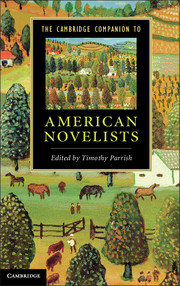Book contents
- Frontmatter
- Contents
- Contributors
- Introduction
- 1 James Fenimore Cooper
- 2 Nathaniel Hawthorne
- 3 Herman Melville
- 4 Harriet Beecher Stowe
- 5 Mark Twain
- 6 Henry James
- 7 Edith Wharton
- 8 Theodore Dreiser
- 9 Willa Cather
- 10 F. Scott Fitzgerald
- 11 Ernest Hemingway
- 12 William Faulkner
- 13 Henry Roth
- 14 Djuna Barnes
- 15 Zora Neale Hurston
- 16 Richard Wright
- 17 Raymond Chandler
- 18 Ralph Ellison
- 19 J. D. Salinger
- 20 Patricia Highsmith
- 21 Vladimir Nabokov
- 22 Jack Kerouac
- 23 Saul Bellow
- 24 Kurt Vonnegut
- 25 John Updike
- 26 Thomas Pynchon
- 27 Toni Morrison
- 28 Philip Roth
- 29 Don DeLillo
- 30 Cormac McCarthy
- Guide to Further Reading
- Index
- References
6 - Henry James
Published online by Cambridge University Press: 05 December 2012
- Frontmatter
- Contents
- Contributors
- Introduction
- 1 James Fenimore Cooper
- 2 Nathaniel Hawthorne
- 3 Herman Melville
- 4 Harriet Beecher Stowe
- 5 Mark Twain
- 6 Henry James
- 7 Edith Wharton
- 8 Theodore Dreiser
- 9 Willa Cather
- 10 F. Scott Fitzgerald
- 11 Ernest Hemingway
- 12 William Faulkner
- 13 Henry Roth
- 14 Djuna Barnes
- 15 Zora Neale Hurston
- 16 Richard Wright
- 17 Raymond Chandler
- 18 Ralph Ellison
- 19 J. D. Salinger
- 20 Patricia Highsmith
- 21 Vladimir Nabokov
- 22 Jack Kerouac
- 23 Saul Bellow
- 24 Kurt Vonnegut
- 25 John Updike
- 26 Thomas Pynchon
- 27 Toni Morrison
- 28 Philip Roth
- 29 Don DeLillo
- 30 Cormac McCarthy
- Guide to Further Reading
- Index
- References
Summary
Shortly after the Civil War, when Henry James (1843–1916) began publishing fiction, the endings of American novels changed. Whereas William Hill Brown’s The Power of Sympathy (1789), Susanna Rowson’s Charlotte Temple (1791), Hannah Webster Foster’s The Coquette (1797), Catharine Maria Sedgwick’s A New-England Tale (1822), James Fenimore Cooper’s The Pioneers (1823), Nathaniel Hawthorne’s The Scarlet Letter (1850), and Harriet Beecher Stowe’s Uncle Tom’s Cabin (1852) all end with tombstones, James’s The Portrait of a Lady (1880–1), William Dean Howells’s The Rise of Silas Lapham (1885), and Abraham Cahan’s Yekl (1896) and The Imported Bridegroom (1898) end with troubled marriages. This shift from public memorial to the dynamics of a largely private relation between persons is not absolute, of course, and it is hard to make the immensely varied body of late nineteenth-century fiction fit any pattern at all. Nevertheless, it seems that a formula that once shaped fiction with extraordinary consistency has broken down and the sense of an ending has changed. In turn, a new sense of the novel emerges, one that Henry James, more than any other writer, brought into being.
At the close of Charlotte Temple, Charlotte’s father gestures toward her tomb as he addresses her seducer: “Look on that little heap of earth…. Look at it often, and may thy heart feel such true sorrow as shall merit the mercy of heaven.” The tomb – here only a mound of earth, since Charlotte has just been buried – creates a public monument out of a personal story; as tombstones so often do in early American novels, this grave has the effect of pulling outward and making legible a private story that nevertheless requires interpretation. Novels that graphically reproduce epitaphic inscriptions on the page – The Coquette, The Scarlet Letter – make out of their characters’ lives a text literally open to all; these figures pass on to the reader the task of interpreting, reflecting on, and remembering.
- Type
- Chapter
- Information
- The Cambridge Companion to American Novelists , pp. 52 - 60Publisher: Cambridge University PressPrint publication year: 2012



